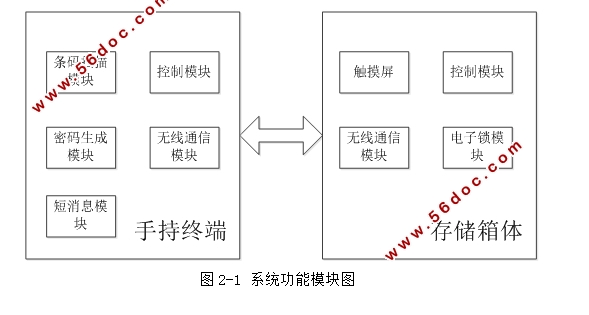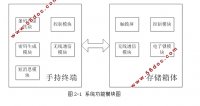智能投递系统的设计
来源:56doc.com 资料编号:5D27843 资料等级:★★★★★ %E8%B5%84%E6%96%99%E7%BC%96%E5%8F%B7%EF%BC%9A5D27843
资料以网页介绍的为准,下载后不会有水印.资料仅供学习参考之用. 密 保 惠 帮助
资料介绍
智能投递系统的设计(任务书,开题报告,外文翻译,论文12200字)
摘 要
现今,电子商务正飞速地发展,而物流是其基础。作为物流公司与客户直接接触的环节,快递员派发物件到客户手中的这一配送环节的质量和效率尤其重要。然而,这一环节存在诸多问题。本文为了解决在物流“最后一公里”配送中存在的一些问题,设计出了一个智能投递系统。
该“智能投递系统”实现了快递员和客户在时间和空间上的分离。快递员扫描物品后把物品放进存储箱体,然后给收件人发送短信让他在方便的时间去箱体处取,他们不需要面对面的接触。系统硬件分为手持终端和存储箱体两部分。采用Cortex-M3内核的STM32F107作为系统主控制器。使用MCR12条码扫描模块扫描物件条码,供控制器处理。利用SIM900A模块向外发送短信,并通过CC2500无线模块实现手持终端和箱体的远程通信。本设计基本实现了快递“最后一公里”快递员和客户之间智能化传递快递的流程。
关键词:最后一公里 手持终端 存储箱体
Intelligent delivery system
Abstract
Nowadays e-commerce is rapidly developing, and logistics is its foundation. As the only part that logistics company directly contacting with customers, the quality and efficiency of the delivery that couriers send items to customers is particularly important. However, there are many problems in this process. In this article, I devised a intelligent delivery system to solve some problems in the delivery of the " The last one mile ".
The " Intelligent delivery system " separates the couriers and customers in time and space. Couriers put items into the storage box after scanning them, and then send short messages to customers to let them go to the box to take their items at their free time .They do not need face to face certainly. The hardware of the system is divided into two parts, handheld terminal and storage box. The system uses STM32F107 as the master controller. The controller processes data by using MCR12 barcode scanning module to scan the bar code of items. It also sends a message to the customer through SIM900A module. The handheld terminal realizes telecommunication with the storage box by using CC2500 wireless communication module. The design realizes the function of the transfer of the delivery between couriers and customers basically.
Key Words: The Last One Mile, Handheld Terminal, Storage Box


目 录
摘 要 I
Abstract II
第一章 绪论 1
1.1 引言 1
1.2 研究背景和意义 1
1.3 研究现状 1
1.4 论文组织结构 2
第二章 系统总体方案设计 3
2.1 系统功能模块 3
2.2 系统总体设计 4
第三章 系统硬件设计 5
3.1 系统主控芯片及其外围电路设计 5
3.1.1 系统主控芯片STM32F107 5
3.1.2 晶振电路 6
3.1.3 复位电路 6
3.1.4 滤波电容 6
3.1.5 JTAG接口电路 7
3.1.6 RS232接口电路 7
3.2 系统电源模块设计 8
3.3 条码扫描模块设计 9
3.3.1 工作原理 9
3.3.2 模块连接 10
3.3.3 模块配置 10
3.4 短消息发送模块设计 11
3.4.1 SIM900A模块接口设计 11
3.4.2 控制指令介绍 11
3.5 无线通信模块设计 12
3.5.1 CC2500模块接口设计 13
3.5.2 数据包格式介绍 14
3.6 触摸屏模块设计 14
3.6.1 数据帧架构 15
3.6.2 数据格式 15
第四章 系统软件设计 17
4.1 系统软件总体设计 17
4.1.1 智能投递系统软件设计 17
4.1.2 发射端主程序流程 17
4.1.3 接收端主程序流程 18
4.2 功能模块程序设计 19
4.2.1 串口通信模块 19
4.2.2 SIM900A通信模块说明 20
4.2.3 SPI通信模块 21
4.2.4 CC2500初始化模块 22
4.2.5 CC2500发射模块说明 23
4.2.6 CC2500接收模块说明 23
4.2.7 触摸屏模块说明 24
第五章 系统调试 26
5.1 系统开发环境简介 26
5.1.1 KEIL MDK编译器 26
5.2 系统软硬件调试 28
5.2.1 系统硬件调试 28
5.2.2 系统软件调试 29
第六章 总结 31
参考文献 32
附录:STM32F107控制板PCB图 33
|





